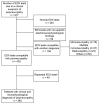Peripheral polyneuropathy from electrodiagnostic tests: a 10-year etiology and neurophysiology overview
- PMID: 34816968
- PMCID: PMC9648933
- DOI: 10.1590/0004-282X-ANP-2020-0561
Peripheral polyneuropathy from electrodiagnostic tests: a 10-year etiology and neurophysiology overview
Abstract
Background: Polyneuropathies are characterized by a symmetrical impairment of the peripheral nervous system, resulting in sensory, motor and/or autonomic deficits. Due to the heterogeneity of causes, an etiological diagnosis for polyneuropathy is challenging.
Objective: The aim of this study was to determine the main causes of polyneuropathy confirmed by electrodiagnostic (EDX) tests in a tertiary service and its neurophysiological aspects.
Methods: This observational cross-sectional study from a neuromuscular disorders center included individuals whose electrodiagnostic tests performed between 2008 and 2017 confirmed a diagnosis of polyneuropathy. Through analysis of medical records, polyneuropathies were classified according to etiology and neurophysiological aspect.
Results: Of the 380 included patients, 59.5% were male, with a median age of 43 years. The main etiologies were: inflammatory (23.7%), hereditary (18.9%), idiopathic (13.7%), multifactorial (11.1%), and diabetes (10.8%). The main electrophysiological patterns were axonal sensorimotor polyneuropathy (36.1%) and "demyelinating and axonal" sensorimotor polyneuropathy (27.9%). Axonal patterns showed greater etiological heterogeneity, with a predominance of idiopathic and multifactorial polyneuropathy, while demyelinating and "demyelinating and axonal" polyneuropathies had a significantly fewer etiologies, with a predominance of hereditary and inflammatory polyneuropathies.
Conclusion: The main causes of polyneuropathy confirmed by EDX test in this study were those that presented a severe, atypical and/or rapidly progressing pattern. Other causes were hereditary and those that defy clinical reasoning, such as multiple risk factors; some polyneuropathies did not have a specific etiology. EDX tests are useful for etiological diagnosis of rare polyneuropathies, because neurophysiological patterns are correlated with specific etiologies.
Antecedentes:: As polineuropatias caracterizam-se por um acometimento simétrico do sistema nervoso periférico, resultando em alterações sensitivas, motoras e/ou autonômicas. Devido à heterogeneidade de causas, estabelecer um diagnóstico etiológico para polineuropatia é desafiador.
Objetivo:: O objetivo desse estudo foi determinar as principais causas de polineuropatia confirmada pela eletroneuromiografia em um serviço terciário e seus aspectos neurofisiológicos.
Métodos:: Esse estudo transversal observacional de um centro de doenças neuromusculares incluiu indivíduos cuja eletroneuromiografia, realizada entre 2008 e 2017, estabeleceu o diagnóstico de polineuropatia. Através da análise dos prontuários, as polineuropatias foram classificadas de acordo com a etiologia e aspecto neurofisiológico.
Resultados:: Dos 380 pacientes incluídos, 59,5% eram homens, com uma mediana de idade de 43 anos. As principais etiologias foram: imunomediada (23,7%), hereditária (18,9%), idiopática (13,7%), multifatorial (11,1%) e diabetes (10,8%). Os principais padrões neurofisiológicos foram polineuropatia axonal sensitivo-motora (36,1%) e polineuropatia mista sensitivo-motora (27,9%). Os padrões axonais demonstraram maior heterogeneidade etiológica, com um predomínio das polineuropatias idiopática e multifatorial, enquanto os padrões desmielinizantes e mistos apresentaram uma significativa restrição de etiologias, com predomínio das polineuropatias hereditária e imunomediada.
Conclusão:: As principais causas de polineuropatia confirmadas pela eletroneuromiografia nesse estudo foram aquelas que apresentaram um padrão de acometimento grave, atípico e/ou rapidamente progressivo, além das polineuropatias hereditárias e daquelas que desafiam o raciocínio clínico, caracterizadas pela presença múltiplos fatores de risco ou pela ausência de uma etiologia. A eletroneuromiografia é útil para o diagnóstico etiológico de polineuropatias raras, já que os padrões neurofisiológicos se correlacionam com etiologias específicas.
Conflict of interest statement
Figures
Similar articles
-
Electrodiagnostic pattern approach for childhood polyneuropathies.Pediatr Neurol. 2006 Jul;35(1):11-7. doi: 10.1016/j.pediatrneurol.2005.11.002. Pediatr Neurol. 2006. PMID: 16814079
-
Hospital-referred polyneuropathies--causes, prevalences, clinical- and neurophysiological findings.Eur J Neurol. 2007 Jun;14(6):603-8. doi: 10.1111/j.1468-1331.2007.01758.x. Eur J Neurol. 2007. PMID: 17539935
-
Electrodiagnostic Testing of Large Fiber Polyneuropathies: A Review of Existing Guidelines.J Clin Neurophysiol. 2020 Jul;37(4):277-287. doi: 10.1097/WNP.0000000000000674. J Clin Neurophysiol. 2020. PMID: 33151658 Review.
-
Pathophysiology inferred from electrodiagnostic nerve tests and classification of polyneuropathies. Suggested guidelines.Clin Neurophysiol. 2005 Jul;116(7):1571-80. doi: 10.1016/j.clinph.2005.04.003. Clin Neurophysiol. 2005. PMID: 15907395
-
Axonal Sensorimotor Polyneuropathies.Continuum (Minneap Minn). 2017 Oct;23(5, Peripheral Nerve and Motor Neuron Disorders):1378-1393. doi: 10.1212/CON.0000000000000514. Continuum (Minneap Minn). 2017. PMID: 28968367 Review.
References
-
- Felix EPV, Oliveira A de SB. Guidelines for the diagnosis of neuropathies in a Reference Center for Neuromuscular diseases. Rev Neurocienc. 2010;18(1):74–80.




